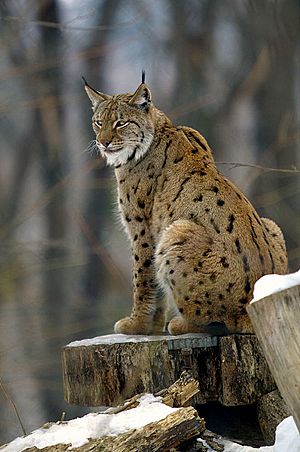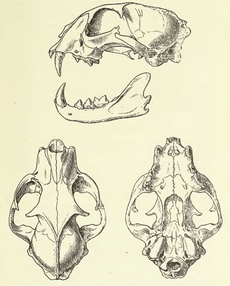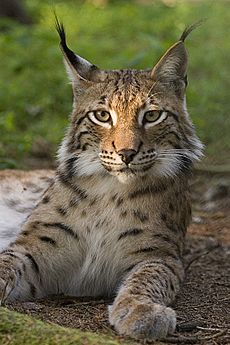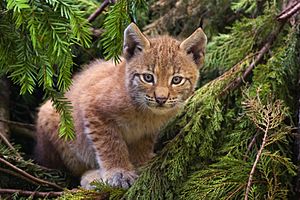Eurasian lynx facts for kids
The Eurasian lynx (Lynx lynx) is a medium-sized cat that lives in Europe and Asia. It is one of the biggest hunters in these areas. It's the largest type of lynx, growing to be about 80 to 130 centimeters (31 to 51 inches) long.
Contents
What Do Eurasian Lynxes Eat?
Lynxes mostly hunt small to medium-sized mammals and birds. They eat hares, rabbits, marmots, squirrels, dormice, and other rodents. They also hunt birds like grouse.
Sometimes, they hunt larger animals like red foxes, wild boar, chamois, young moose, roe deer, red deer, and reindeer. Hunting bigger animals can be risky for the lynx. But the large amount of food they get makes it worth it.
Eurasian lynxes prefer to hunt large hoofed animals, especially in winter. This is when smaller prey is harder to find. They are the only lynx species that eats more hoofed animals than hares or rodents. If there are many roe deer around, lynxes will usually hunt them. Even if roe deer are rare, they are still a favorite food. In some parts of Finland, lynxes eat White-tailed deer. In Poland and Austria, they prefer red deer, and in Switzerland, they hunt chamois.
Lynxes also eat carrion (animals that are already dead) if they find it. Adult lynxes need about 1.1 to 2 kilograms (2.4 to 4.4 pounds) of meat every day. They might take several days to finish eating a large animal they have caught.
Where Do Eurasian Lynxes Live?
Eurasian lynxes live across a wide area.
Asia
You can find them in parts of China and Northern Pakistan. They also live in Central Asia, including Mongolia, Kazakhstan, Uzbekistan, Turkmenistan, Kyrgyzstan, Tajikistan, and Afghanistan. In India, they are found in areas like Kashmir and Himachal Pradesh. They also live in northern Nepal and parts of Pakistan. In Turkey, efforts are being made to protect them, and new groups of lynxes have been found.
Europe
Long ago, Eurasian lynxes were common all over Europe. But by the mid-1800s, they had disappeared from most of Central and Western Europe. Luckily, people have successfully brought them back to many forests.
- Russia: Most Eurasian lynxes live in Russia. In 2013, there were about 22,510 lynxes there, and their numbers are steady.
- Finland: In 2008, there were about 1,905 to 2,060 lynxes in Finland. Their numbers have been growing since 1991.
- Sweden: In Sweden, there are about 1,400 lynxes.
- Norway: Norway has between 409 and 439 lynxes.
- Carpathian Mountains: About 2,800 lynxes live in this mountain range, which includes countries like the Czech Republic, Poland, and Romania. This is the largest group of Eurasian lynxes west of Russia.
- Balkan Peninsula: A special type of lynx called the Balkan lynx lives in countries like Croatia, Montenegro, and North Macedonia. It's a national symbol of North Macedonia. These lynxes are very rare, with only about 100 left, mainly due to illegal hunting.
- Great Britain: Lynxes used to live in Great Britain a long time ago. Now, some people are interested in bringing them back to help control the deer population.
- Germany: The Eurasian lynx disappeared from Germany in 1850. But they were brought back in the 1990s to places like the Bavarian Forest.
- Switzerland: Lynxes became extinct in Switzerland in 1915 but were brought back in the 1970s. As of 2014, there were about 173 lynxes there.
Physical Characteristics of the Eurasian Lynx
The Eurasian lynx is the biggest lynx species. It can be 80 to 130 cm (31 to 51 in) long and stands 60 to 75 cm (24 to 30 in) tall at the shoulder. Its tail is short, only 11 to 24.5 cm (4.3 to 9.6 in) long.
Male lynxes usually weigh from 18 to 30 kg (40 to 66 lb). Females are smaller, weighing 8 to 21 kg (18 to 46 lb). The largest males, found in Siberia, can weigh up to 38 kg (84 lb) or even 45 kg (99 lb).
Lynxes have strong, long legs and big, webbed paws with fur. These paws act like snowshoes, helping them walk on snow. They have a short, "bobbed" tail with a black tip. Their ears have black tufts of hair, and they have a long grey-and-white ruff (fur around their neck).
In summer, their fur is short and can be reddish or brown. In winter, they grow a much thicker, silky coat that is silver-grey to greyish-brown. Their belly, neck, and chin are white all year. Their fur usually has black spots, but the number and pattern of these spots can be very different from one lynx to another. Some lynxes also have dark brown stripes on their forehead and back.
Sounds and Silence
Eurasian lynxes make different sounds, but they are usually quiet when it's not mating season. They can mew, hiss, growl, and purr. Like house cats, they might "chatter" at prey they can't reach. During mating season, their calls are much louder. Males make deep growls, and females make loud "meow"-like sounds.
Lynxes are very secretive. The sounds they make are quiet and rare, so people might not know they are in an area for years. Usually, people see their tracks in the snow or leftover prey before they actually see a lynx.
Behaviour and Hunting
Eurasian lynxes are mainly active at night or during twilight (dawn and dusk). They spend the day sleeping in thick bushes or other hidden spots. Adult lynxes live alone.
Their main way of hunting is by stalking, sneaking up on their prey, and then jumping on it. They can also hide and wait to ambush prey if the conditions are right. In winter, certain snow conditions can make hunting harder, forcing them to hunt larger animals.
Eurasian lynxes use both their sight and hearing to hunt. They often climb onto high rocks or fallen trees to look around. They are very powerful hunters and have successfully killed deer weighing at least 150 kg (330 lb).
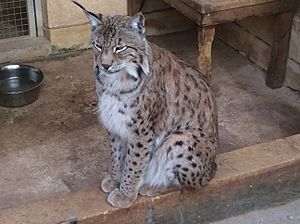
Eurasian lynxes live in rugged, forested areas that offer many places to hide and stalk prey. This can include forests with grasslands, northern forests (like boreal forests), and mountain forests. In mountainous areas, lynxes will move down to lower lands in winter to follow their prey and avoid deep snow.
Lynxes tend to be less common where wolves live, as wolves have been known to attack and even eat lynxes. In Russian forests, the main predators of the Eurasian lynx are grey wolves and wolverines. Wolves kill lynxes that can't escape into trees. Lynx populations go down when wolves are in an area. Wolverines are tough competitors for food and often steal kills from lynxes. Lynxes usually avoid wolverines, but they might fight them to protect their kittens. Sometimes, Siberian tigers also hunt lynxes.
Lynxes compete for food with other animals like red foxes, eagle owls, golden eagles, and wild boar (which eat leftovers from lynx kills). In warmer areas, they also compete with snow leopards and leopards.
The hunting area of a Eurasian lynx can be very large, from 20 to 450 square kilometers (8 to 174 square miles). The size depends on how much prey is available. Male lynxes usually hunt over much larger areas than females. Females tend to have their own hunting areas that don't overlap with other females.
A Eurasian lynx can travel up to 20 km (12 mi) in one night, though half that distance is more common. They regularly patrol their hunting areas. They use scent marks, like poop, urine, or scratch marks, to show other lynxes they are there. These marks are often left in noticeable places along the edge of their hunting territory.
Life Cycle and Reproduction
The mating season for Eurasian lynxes is from January to April. The female usually goes into heat only once during this time, for about four to seven days. If her first litter of kittens is lost, she might go into heat a second time. Unlike the Canada lynx, the Eurasian lynx doesn't seem to change its breeding based on how much prey is available. This might be because they eat a wider variety of prey, so it's less common for them to run out of food.
Pregnant females build dens in hidden places, often protected by tree branches or roots. They might line the den with feathers, deer hair, and dry grass to make a soft bed for their babies. Pregnancy lasts from 67 to 74 days. A female gives birth to one to four kittens.
At birth, Eurasian lynx kittens weigh 240 to 430 grams (8.5 to 15.2 oz). They are born blind and helpless. Their fur is plain and grayish-brown at first. They get their full adult colors around eleven weeks old. Their eyes open after ten to twelve days.
Kittens start eating solid food when they are six to seven weeks old, which is when they begin to leave the den. But they are not fully weaned (stopped drinking milk) until they are five or six months old.
The den is left behind two to three months after the kittens are born. However, the young lynxes usually stay with their mother until they are about ten months old, which is when the next breeding season starts. Eurasian lynxes become ready to have their own babies at two or three years old. In zoos, they have lived for up to twenty-one years.
Images for kids
-
Postage stamp from the Soviet Union, 1988
-
Eurasian lynx at the Zoo Aquarium de Madrid
See also
 In Spanish: Lince boreal para niños
In Spanish: Lince boreal para niños


